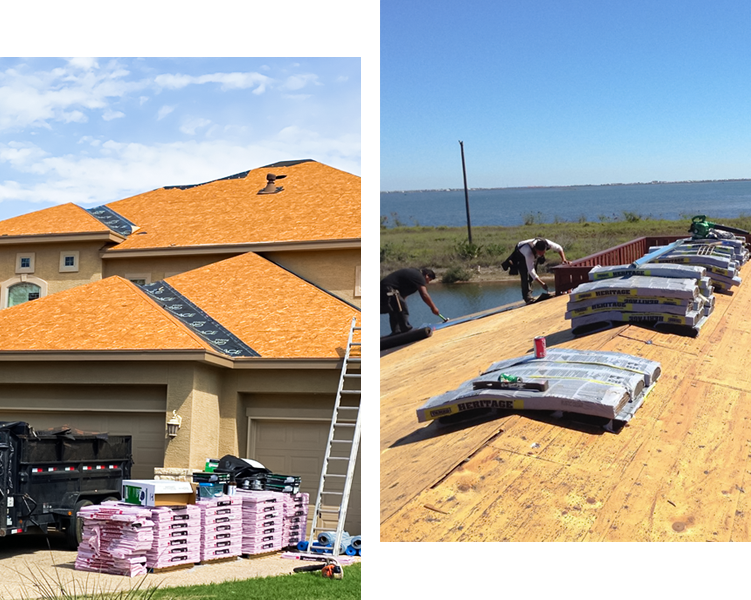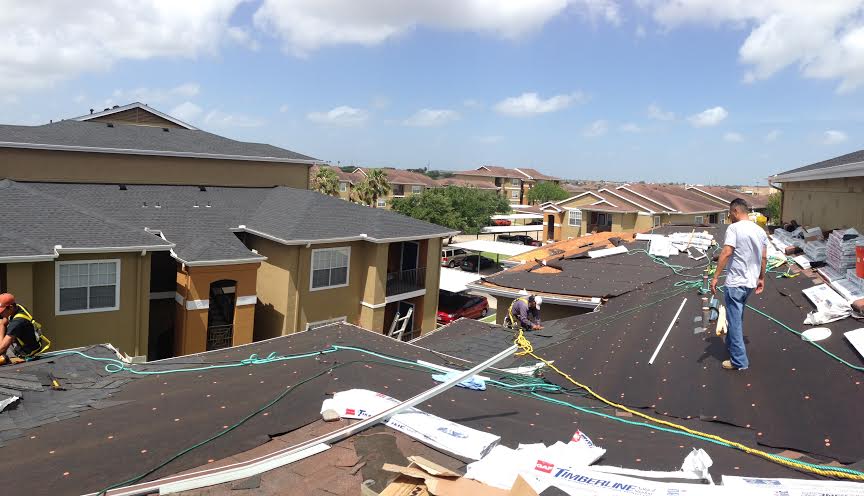As the winter season approaches, you may find yourself sipping hot cocoa by the fire, watching as fluffy snowflakes gently blanket your home in a layer of white. While this scene paints a picture of serenity and calm, it’s crucial not to overlook one key aspect – the roof above your head. Your roof is what keeps you warm and snug during these frosty months. But have you ever thought about how well-equipped it is to handle that heavy load of snow?
Don’t worry! We’ve got you covered with our ultimate guide to keeping your roof snow-ready. This insightful guide will help you spot structural weak points in your roof, maintain gutters properly, and evaluate insulation and ventilation adequacy.
You’ll also learn how to manage ice dams effectively, identify potential damage early on, and understand when it’s time to call in professionals for snow removal. Let this winter be a season of comfort and joy rather than stress over unexpected roofing issues!
Here’s what you need to do:
Inspecting the Structure for Weak Points

Before winter hits, you’ll want to thoroughly inspect your roof’s structure for any weak points that could buckle under the weight of heavy snow. And no, don’t worry, this isn’t as daunting as it sounds! You’re just playing detective here, looking out for signs of structural vulnerabilities detection.
Start by scanning for obvious issues like missing or loose shingles, sagging areas, rusted flashing or gutters – all these might raise a red flag. But remember, some problems aren’t quite visible to the untrained eye. So you might need help from an expert roofer who knows exactly what to look for and how to address it.
After your investigation is done and if you’ve unearthed any potential concerns, let’s move on to step two – reinforcing your roof before the winter kicks in. Various roof reinforcement techniques come into play here. Think about adding extra support beams or cross bracing in vulnerable areas.
Here’s a tip: consider using materials designed specifically to withstand extreme weather conditions. These may cost a bit more but trust me, it’s worth it in the long run. Remember that maintaining your home isn’t just about keeping up appearances. It’s about creating a safe and comfortable space where memories are made and families grow together.
Properly Cleaning and Maintaining Gutters
Ensuring your gutters are squeaky clean and well-maintained is an essential step to take in preparing for those chilly winter months. All that snow melting off your roof needs a clear path to flow away from the house. Without proper maintenance, clogged gutters can lead to ice dams which can cause significant damage to your roof and home.
Now you might be thinking, “How do I keep my gutters free of debris?”This is where Gutter Guards Usage comes into play. They’re like little superheroes for your gutters – keeping out leaves, twigs, and other pesky debris while allowing water to flow freely.
But it’s not just about the gutters themselves – you also need to focus on Downspout Maintenance. These often overlooked components play a vital role in directing water safely away from your house’s foundation.
So make sure they are properly attached and extend at least five feet from the house – if not, consider adding downspout extensions. Just imagine yourself enjoying a cup of hot cocoa by the fireplace, knowing that outside, your gutter system is effectively doing its job keeping harmful ice dams at bay – a comforting thought indeed!
Evaluating Insulation and Ventilation
After you’ve tackled your gutters and downspouts, it’s time to take a look at your home’s insulation and ventilation. They’re the unsung heroes in making sure Jack Frost doesn’t sneak into your cozy abode. You might not realize it, but these two crucial components go hand in hand when it comes to keeping your house warm during those frosty winter months.
You see, proper insulation keeps the warmth inside while good ventilation ensures that any excess moisture or heat can escape safely without causing damage. But how do you know if your current setup is up to snuff? Well, my friend, let’s dive into the world of insulation materials comparison.
The most common types of insulation are fiberglass, cellulose, and spray foam – each with their unique pros and cons. Fiberglass is cost-effective and easy to install but doesn’t perform well in extreme temperatures. On the other hand, cellulose provides better thermal performance but can be tricky to install correctly.
Then there’s spray foam – a bit more expensive but offers excellent air sealing properties which may save you money on energy bills over time. Now that we’ve covered insulation let us breeze through some ventilation system upgrades for optimal snow-readiness! Your attic should have a balance between intake vents (soffit or eave vents) and exhaust vents (ridge or roof vents).
If this harmony is off-kilter, consider upgrading your system for better efficiency. Remember an efficient ventilation system prevents ice dams formation by eliminating excessive heat buildup under the roof sheathing. So get proactive about caring for your home’s bones because baby…it’s cold outside!
Managing Ice Dams

Don’t let those icy invaders, known as ice dams, wreak havoc on your beloved home this winter! It’s time to gear up for some serious ice dam prevention. You see, these frosty foes form when snow melts off your roof and refreezes at the edges.
This creates a barrier, or ‘dam’, that prevents further melting snow from draining off your roof. The water then backs up behind the dam and seeps into your precious home causing what we call ‘dam related leaks’. Think damp insulation, ruined plaster or drywall, peeling paint; not exactly the kind of winter wonderland you had in mind!
So how do you keep these unwelcome guests at bay? First off, make sure you’ve got good attic insulation; it keeps the heat where it belongs – inside your house and away from your rooftop. Next comes ventilation; proper airflow in the attic helps maintain an even temperature on the roof surface which minimizes snow melting and refreezing cycles. And remember those gutters? Keep them clear of leaves and debris so melted snow has a smooth exit path off your roof. A bit of winter vigilance can save you a whole lot of springtime sorrow!
Recognizing and Addressing Damage Early
Spotting signs of damage early and dealing with them promptly can save you a heap of trouble down the line. Let’s chat about those pesky damage indicators that could be lurking on your roof right now, waiting for the first snowfall to make their presence felt. Your roof talks to you in subtle ways, and it’s crucial to understand its language. Look out for missing or cracked shingles, rust spots on flashing, or moss and lichen growth – these are all telltale signs that your roofing materials may not be up to par.
Now that we’ve recognized potential issues together, let’s roll up our sleeves and address them head-on! Engage a professional roofer if you spot any serious damage. They are trained in detecting problems that might miss an untrained eye.
But there are smaller things you can handle yourself too. Clean off any loose debris from your roof regularly, keep gutters clean, replace damaged shingles promptly – these little actions can go a long way in keeping your roof snow-ready. Remember, it’s all about teamwork between you and your home; listen to its whispers so it won’t have to scream!
Hiring Professionals for Snow Removal
While it’s great to tackle minor maintenance tasks yourself, there’s a time and place for calling in the pros – especially when it comes to snow removal. You might be contemplating which shovel or snowblower to buy from the vast array of snow equipment choices available. However, remember that pros have access to specialized tools that can make the job more efficient and safer.
They’ve been trained on how best to handle these machines without damaging your roof or endangering themselves. Hiring professionals means you’re not only investing in expert service but also ensuring your peace of mind.
Moreover, let’s talk about liability considerations. If you decide to brave the cold and get up on that slippery roof yourself, bear in mind that any accidents could lead not only to physical harm but potential legal complications as well.
On the other hand, professional snow removal companies are insured against such incidents. This coverage transfers any risk from you onto them while they’re working on your property. Therefore, hiring professionals is not just about convenience; it’s about protecting yourself legally too!
Regular Maintenance Tips for Winter Months
As the chilly winter months roll in, it’s crucial for you to get proactive about regular maintenance tasks around your home to prevent any potential damage. Your roof, being a primary shield against the harsh weather conditions, needs some special care and attention.
Familiarize yourself with effective roof shoveling techniques that can help eliminate snow build-up without causing harm to your roof structure. The right approach is not just about removing snow; it’s also about doing so safely and efficiently.
Investing in winter-proof materials is another great step towards keeping your roof snow-ready. These materials are designed to withstand extreme conditions and offer enhanced protection against ice dams and leaks that often occur due to snow melting and refreezing on your roof.
Be a little extra cautious when choosing insulation materials too; well-insulated roofs retain less heat, reducing the chances of ice dam formation. Remember, every small effort counts when it comes to protecting your home from winter woes!
